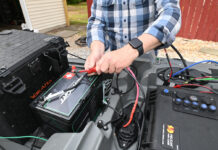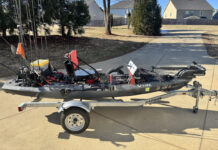Livewells are a fixture on fishing boats from bass glitter rockets to offshore cruisers, where they serve two essential purposes. The most common is keeping fin bait in good shape, whether minnows or mackerel. The second use is familiar to anyone who watches big-league bass tournaments; if you’re going to catch, weigh and release, you need a livewell on your fishing kayak to act as a mobile aquarium.
How to buy, install and use a livewell on your fishing kayak
Livewells aren’t complicated. Most systems work by pumping a constant flow of water through a tank; the overflow drains directly overboard or into a scupper. They usually mount—where else?—in the tank well.
1 Purchasing a store-bought livewell
Installing a livewell in your fishing kayak can be as easy as a run to the store. Hobie’s model is top of the line, although it only fits their boats. Shimano’s Bristol Bay Portable Live Well is another fine option, but hurry. It may not be available much past 2009.
These are just for starts; many fishing-savvy kayak shops sell locally popular versions similar to what you’d make at home, only these guys are well practiced from cranking out dozens. Expect to pay $150 or more.
2 DIY fishing kayak livewells
If you want to make your own, all you’ll need is a suitable container, an inexpensive submersible bilge pump like the Attwood T500, a length of flexible hose, a 12- or 6-volt battery, a spray nozzle and a bit of hardware. Popular containers include the humble 5-gallon utility bucket, bulk pet food bins, and small coolers. Virtually any plastic container will work, with round sides preferred for bait and rectangular varieties for bass. The parts might run as much as $75 to $100. Examples are readily available on the Internet.
3 Inflow / out-go
The simplest fishing kayak livewells are known as pump draggers—the pump is literally thrown overboard beside the kayak. There’s a bit of drag—not much, but noticeable—and they sometimes hang up on floating weeds or kelp. The alternative is to draw water through a scupper. These units often require priming, either through an inline hand pump or your used coffee cup. The drain? All it takes is a bunch of holes drilled at the appropriate level, or a second hose that points overboard.

4 Powering up
The most commonly used bilge pumps can move 360 or 500 gallons per hour. That’s overkill for a 5-gallon tank, the kayak average. The solution is to wire the pump so it runs backwards, reducing the flow, or deliberately underpower it by going with a 6-volt battery. Most people favor rechargeable sealed lead-acid batteries; a 7-amp model should get you through a couple of long days on the water. In a pinch, a disposable 6-volt lantern battery can get you going.
5 Getting fancy
When you get right down to it, all you need is an electrical circuit. Those who prefer more elegant equipment mount on/off toggles, fuse-protected timer switches, and waterproof battery boxes. Be sure to use marine grade fixtures or they won’t last long. A lid will keep bait and bass from jumping out.
6 Using your livewell
Don’t do the twist: Access your livewell when sitting side-saddle in your fishing kayak or turning around to face the tank. Twisting your head and shoulders over the side can lead to an unplanned swim.
Baiting up: For the best results, avoid overcrowding your fin bait. When it’s time to scoop one up, move slowly and trap one in the corner. Stressed out, damaged bait doesn’t fish as well as those in perfect condition.
The bass boogie: With bass, usually the hardest part is getting them out of the tank. Consider a culling system that clips onto the mouth of each fish, and don’t build covered corners into your tank.
Add a livewell to boost your kayak’s fishing performance. | Feature Illustration: Paul Mason




 Wilderness Systems
Wilderness Systems YakGear
YakGear




